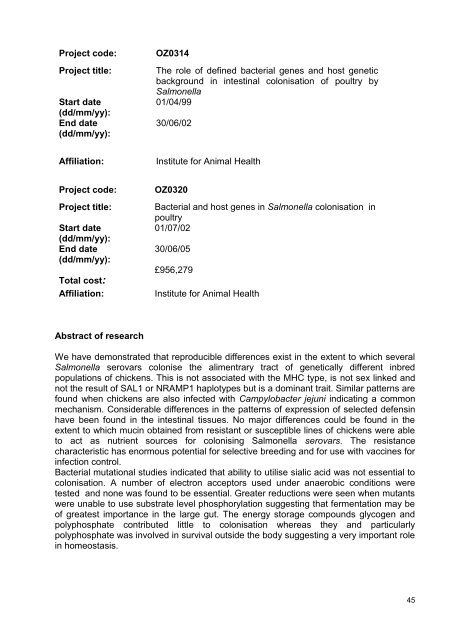Review of the Food-borne Zoonoses Research ... - ARCHIVE: Defra
Review of the Food-borne Zoonoses Research ... - ARCHIVE: Defra
Review of the Food-borne Zoonoses Research ... - ARCHIVE: Defra
You also want an ePaper? Increase the reach of your titles
YUMPU automatically turns print PDFs into web optimized ePapers that Google loves.
Project code: OZ0314<br />
Project title: The role <strong>of</strong> defined bacterial genes and host genetic<br />
background in intestinal colonisation <strong>of</strong> poultry by<br />
Salmonella<br />
Start date<br />
01/04/99<br />
(dd/mm/yy):<br />
End date<br />
(dd/mm/yy):<br />
30/06/02<br />
Affiliation: Institute for Animal Health<br />
Project code: OZ0320<br />
Project title: Bacterial and host genes in Salmonella colonisation in<br />
poultry<br />
Start date<br />
01/07/02<br />
(dd/mm/yy):<br />
End date<br />
30/06/05<br />
(dd/mm/yy):<br />
£956,279<br />
Total cost:<br />
Affiliation: Institute for Animal Health<br />
Abstract <strong>of</strong> research<br />
We have demonstrated that reproducible differences exist in <strong>the</strong> extent to which several<br />
Salmonella serovars colonise <strong>the</strong> alimentrary tract <strong>of</strong> genetically different inbred<br />
populations <strong>of</strong> chickens. This is not associated with <strong>the</strong> MHC type, is not sex linked and<br />
not <strong>the</strong> result <strong>of</strong> SAL1 or NRAMP1 haplotypes but is a dominant trait. Similar patterns are<br />
found when chickens are also infected with Campylobacter jejuni indicating a common<br />
mechanism. Considerable differences in <strong>the</strong> patterns <strong>of</strong> expression <strong>of</strong> selected defensin<br />
have been found in <strong>the</strong> intestinal tissues. No major differences could be found in <strong>the</strong><br />
extent to which mucin obtained from resistant or susceptible lines <strong>of</strong> chickens were able<br />
to act as nutrient sources for colonising Salmonella serovars. The resistance<br />
characteristic has enormous potential for selective breeding and for use with vaccines for<br />
infection control.<br />
Bacterial mutational studies indicated that ability to utilise sialic acid was not essential to<br />
colonisation. A number <strong>of</strong> electron acceptors used under anaerobic conditions were<br />
tested and none was found to be essential. Greater reductions were seen when mutants<br />
were unable to use substrate level phosphorylation suggesting that fermentation may be<br />
<strong>of</strong> greatest importance in <strong>the</strong> large gut. The energy storage compounds glycogen and<br />
polyphosphate contributed little to colonisation whereas <strong>the</strong>y and particularly<br />
polyphosphate was involved in survival outside <strong>the</strong> body suggesting a very important role<br />
in homeostasis.<br />
45

















